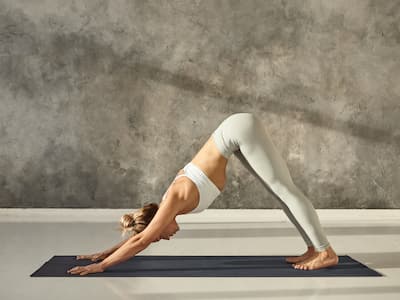Don’t Miss Out on the Latest Updates.
Subscribe to Our Newsletter Today!
Downward Facing Dog (Adho Mukha Svanasana): How To Practice, Benefits And Precautions

Downward Facing Dog is one of the most practised yoga poses out there. Read on to know how to do it properly, common mistakes you should avoid and precautions to take while practising this relaxing yoga pose.
Downward Facing Dog (Adho Mukha Svanasana) might be the first yoga you learn as you start doing yoga. The name Adho Mukha Svanasana comes from Sanskrit words: adhas meaning 'down,' mukha meaning 'face,' svana meaning 'dog' and asana meaning 'posture'. It is one of the most widely recognized yoga poses that provide an ample amount of health benefits for people. This pose helps stretch, tones, and lengthens the entire spinal column. The nervous system is stimulated and decongested by it. Here are all the benefits of doing Downward Facing Dog.
Benefits Of Downward Facing Dog
There are many health benefits of practising Adho Mukha Svanasana, including:
- This asana works several muscles of your body and engages your core
- It strengthens the bones, making your body strong and preventing conditions like osteoporosis
- Downward Facing Dog helps stretch the calves and hamstrings as well
- Since you are in an inverted V position, the blood flow goes to your head, which in turn helps you focus and makes you feel more energetic
- It helps engage your upper body, thereby strengthening and toning the arms
- Adho Mukha Svanasana opens the shoulders and lengthens the spine, which in turn, help ease the back and neck pain
- The downward-facing dog is a back-stretching pose that can help relieve back pain. Stretching the spine improves oxygen delivery to various regions of the body
How To Do The Asana?
Here's how to do this yoga asana:
Also Read
- Come on your hands and knees, with your wrists under your shoulders and your knees under your hips
- Lift your hips and straighten your legs by curling your toes under and pushing back through your hands
- Ground down from the forearms to the fingertips by spreading your fingers
- Rotate your upper arms outwards to expand the collarbones
- Allow your head to hang and your shoulder blades to move away from your ears and toward your hips
- Engage your quads to remove the weight of your body off your arms. This motion contributes significantly to making this a resting stance
- Rotate your thighs inward, lowering your heels to the floor
- Make sure you have formed a plank position, and the distance between the hands and feet should be the same
- To get the heels on the floor in Down Dog, do not step the feet toward the hands
- Exhale and bend your knees to release, then return to your hands and knees
Beginner's Tips
- To protect your wrists, make sure the first finger's knuckle is firmly pressed down
- Return your weight to your hips
- If you are hypermobile, keep a micro-bend in your arms to avoid locking your elbows
- Check if your shoulders are hunched up; if so, nod and shake your head to keep the base of your neck relaxed
Precautions To Take
You should avoid doing this pose if you have a wrist injury or carpal tunnel syndrome. Pregnant women in their last trimester should also avoid doing this pose. People should also avoid if they have high blood pressure, heart illness, vertigo, or a slipped disc in their spine.


